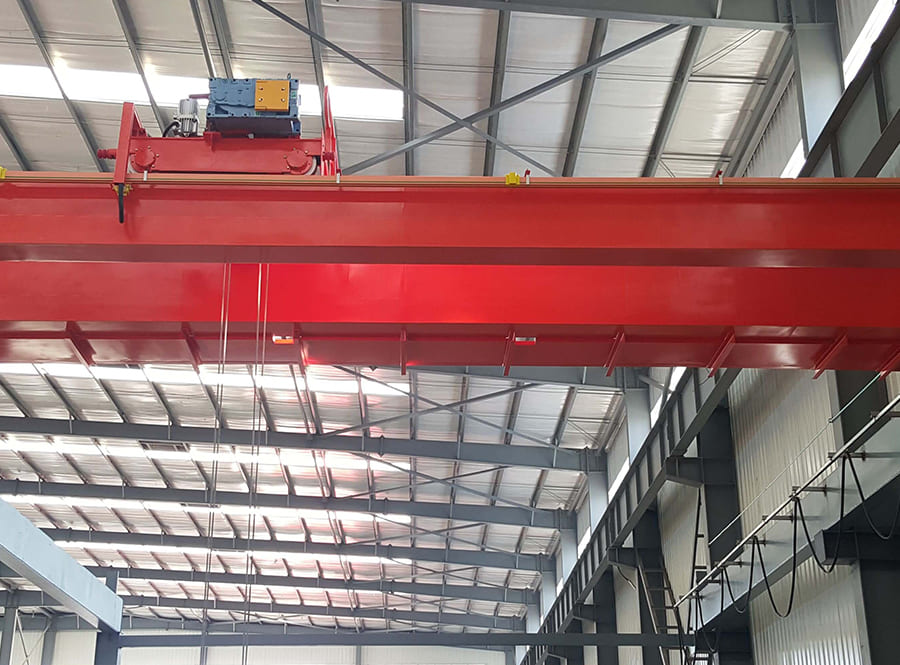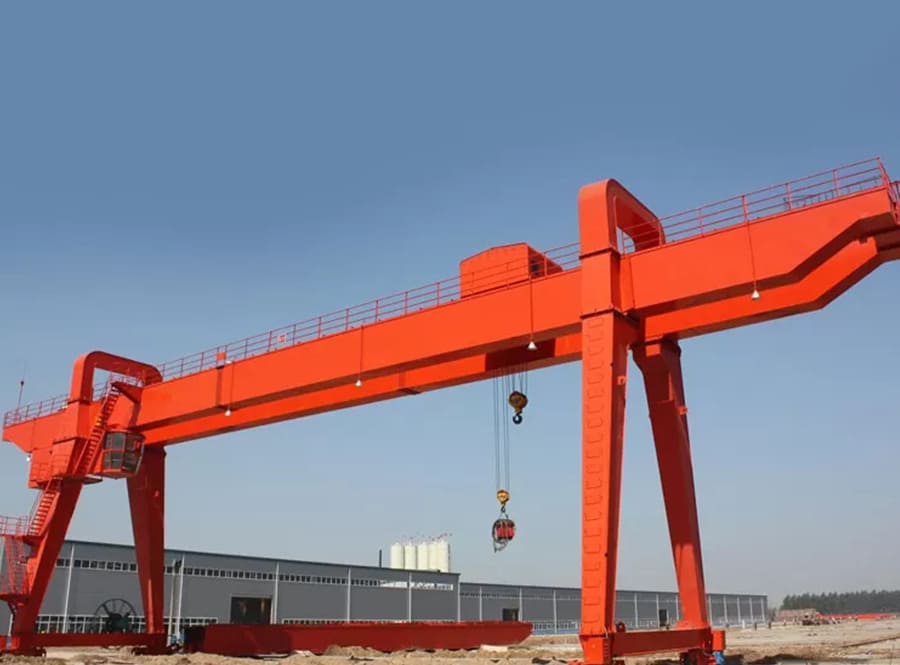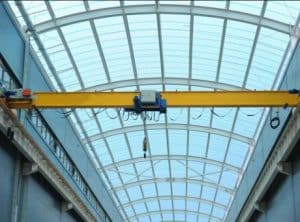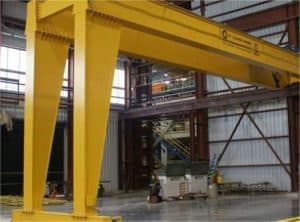Una grúa suspendida, también conocida como grúa móvil o grúa puente suspendida, es un tipo de grúa aérea en la que el puente (viga horizontal) se apoya en la estructura del edificio y el polipasto y el carro se desplazan a lo largo del ala inferior del puente. A diferencia de las grúas móviles, las grúas suspendidas no requieren un sistema de carriles ni columnas de soporte en el nivel del suelo, lo que las hace adecuadas para instalaciones con altura libre limitada o limitaciones de espacio.

A continuación se presentan algunas características y características clave de las grúas suspendidas:
- Estructura del puente: El puente de una grúa suspendida suele tener una configuración de una sola viga, que consta de una viga horizontal que corre paralela a la estructura del edificio. El puente está suspendido del techo o de la estructura de soporte superior mediante perchas o varillas de suspensión.
- Polipasto y carro: El conjunto polipasto y carro se monta en la brida inferior del puente. El polipasto se encarga de elevar y bajar la carga, mientras que el carro se desplaza horizontalmente a lo largo del puente, permitiendo posicionar la carga en diferentes puntos dentro del área de cobertura de la grúa.
- Desplazamiento suave: las grúas suspendidas ofrecen un movimiento suave y preciso gracias a la baja fricción que proporciona el sistema de carro de desplazamiento inferior. Esto permite una manipulación y posicionamiento eficientes de la carga.
- Diseño compacto: las grúas suspendidas tienen un diseño compacto que requiere menos espacio vertical en comparación con las grúas suspendidas. Esto las hace adecuadas para instalaciones con poca altura libre u obstrucciones en el techo.
- Cobertura flexible: las grúas suspendidas pueden proporcionar una cobertura total del área de trabajo debajo del puente al extender el carro y el polipasto más allá del tramo del puente. Esto permite una manipulación eficiente de los materiales dentro de un espacio de trabajo definido.
- Aplicaciones de servicio ligero a mediano: Las grúas suspendidas se utilizan comúnmente para aplicaciones de servicio ligero a mediano donde la capacidad de carga suele ser de hasta unas pocas toneladas. Suelen encontrarse en instalaciones de fabricación, talleres, almacenes y líneas de montaje.
- Opciones personalizables: Las grúas suspendidas se pueden personalizar para adaptarse a los requisitos específicos de la aplicación. Se pueden equipar con diversas funciones, como controles de velocidad variable, controles remotos por radio y accesorios de elevación especializados para mejorar la eficiencia y la seguridad.
Al utilizar grúas suspendidas, es fundamental priorizar la seguridad para evitar accidentes y garantizar el bienestar de los trabajadores. A continuación, se presentan algunas consideraciones de seguridad comunes al operar grúas suspendidas:
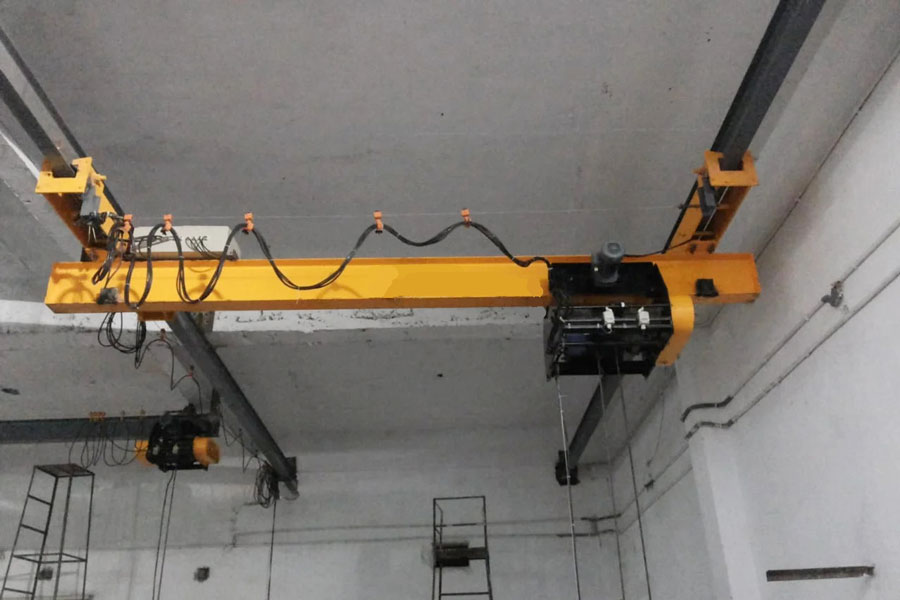
- Capacitación del operador: solo personal capacitado y autorizado debe operar grúas suspendidas. Los operadores deben recibir capacitación integral sobre el funcionamiento de la grúa, que incluya la comprensión de los controles, las capacidades de carga y los protocolos de seguridad. También deben estar familiarizados con las características y limitaciones específicas de la grúa suspendida que se esté utilizando.
- Inspección y mantenimiento: La inspección y el mantenimiento periódicos de las grúas suspendidas son esenciales para garantizar su funcionamiento seguro. Esto incluye la inspección de los componentes de la grúa, como el puente, el polipasto, el carro y los sistemas eléctricos, para detectar cualquier signo de daño, desgaste o mal funcionamiento. Cualquier problema debe ser abordado y reparado de inmediato por técnicos calificados.
- Capacidad de carga y limitaciones: es fundamental respetar los límites de capacidad de carga especificados por el fabricante. Sobrecargar una grúa suspendida puede provocar fallas estructurales, poniendo en peligro al personal y causando daños al equipo. Se debe realizar una evaluación de carga adecuada antes de levantar la grúa para asegurarse de que se encuentre dentro de la capacidad nominal de la grúa.
- Espacios libres y obstáculos: asegúrese de que haya suficiente espacio libre entre la grúa y cualquier obstáculo, como paredes, vigas o equipos. Se debe mantener un espacio libre adecuado para evitar colisiones y permitir el movimiento seguro de la grúa y la carga.
- Fijación segura de la carga: Sujete correctamente la carga al accesorio de elevación del polipasto, como ganchos, eslingas o dispositivos de elevación especializados. Verifique que la carga esté bien sujeta antes de levantarla para evitar accidentes o inestabilidad de la carga durante la operación.
- Protección contra caídas: Los trabajadores que participan en la operación de grúas suspendidas deben usar equipo de protección personal (EPP) adecuado, que incluya cascos, gafas de seguridad y ropa de alta visibilidad. Se deben implementar medidas de protección contra caídas, como el uso de arneses y posicionamiento adecuados en la grúa, para los trabajadores que accedan a la grúa o trabajen en alturas.
- Comunicación y señalización: establezca protocolos de comunicación claros entre el operador de la grúa y los trabajadores en tierra. Utilice señales estandarizadas o comunicación por radio para garantizar una comunicación eficaz durante los movimientos de la grúa.
- Parada y respuesta de emergencia: las grúas suspendidas deben estar equipadas con un botón de parada de emergencia que pueda detener rápidamente las operaciones de la grúa en caso de una emergencia o situación peligrosa. Los operadores deben estar familiarizados con los procedimientos de respuesta de emergencia y saber cómo responder de manera segura y eficiente a las emergencias.
- Consideraciones ambientales: tenga en cuenta factores ambientales como el viento, la lluvia o las temperaturas extremas al operar grúas suspendidas al aire libre. Siga las pautas de seguridad específicas para las operaciones con grúas al aire libre y tome las precauciones necesarias para garantizar una operación segura en condiciones climáticas variables.
Es importante consultar las regulaciones y pautas aplicables, así como las recomendaciones del fabricante, para conocer las consideraciones y los requisitos de seguridad específicos relacionados con las operaciones de grúas suspendidas en su región.








